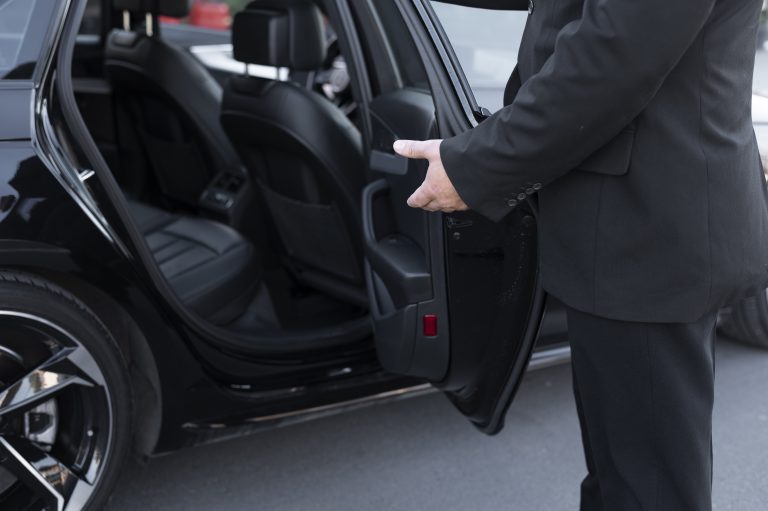Limousine Management system
Introduction :

Based on our studies directed within the Kingdom of Saudi Arabia market with the aim of developing systems specialized in resource planning for large and medium enterprises (ERP) that serve the nature of the activity of these establishments with non-traditional and distinct specialization, and because these establishments with non-traditional specialization and distinguished by a special nature are considered limited in number, they have not received that attention. It is one of the facilities specialized in developing integrated and interconnected systems and applications (ERP) with accounting and human resources systems as an integrated, unified system. We acknowledge, as a result of these studies and field examination,
the existence of some software solutions that address some of the necessary procedures for these activities independently, away from their connection to the financial and administrative systems of these facilities, which are not It provides a comprehensive and integrated solution, such that these establishments are forced to purchase and use several financial or administrative systems that operate independently of the system of a distinct nature, and they are forced to attempt to link a set of these systems with the system that represents the nature of the facility’s distinct activity. According to our observations, these linking processes are vulnerable to the emergence of errors and mismatches. In the results of operations and their balances between these systems, in addition, the facility that is forced to make this option needs additional human cadres whose task is to make comparisons and matches of the general account balances in the general accounting system and the analytical account balances in the systems associated with them due to the special and distinct activity.
Based on our conviction of the necessity of developing integrated and interconnected systems (ERP) specialized for establishments with distinguished and unconventional activities, we explain below the technical details of the integrated limousine company management system, which serves the nature of the activity of limousine companies and institutions of a distinguished nature within the Kingdom of Saudi Arabia, a comprehensive system to serve all departments and divisions. Finance, human resources management, warehouse systems, procurement, regular maintenance, breakdown maintenance, and follow-up accident procedures in order to be specific to and supportive of the limousine activity.
List of components of ERP companies’ systems :
-
- User control and powers
- Database management
- Financial systems
- Human resources system
- Fixed assets system
- Purchasing and warehouse system
- Workshop and maintenance system
- Limousine management system
The main menu configuring the limousine management system :
First: System Settings
-
- Defining and classifying the types of violations, whether they are traffic violations or transportation violations, specifying whether the violation is borne by the company’s expenses or borne by the driver.
- Classification of vehicles or cars according to their categories in terms of being light, small, medium, or higher than medium.
- Another classification of vehicles or cars in terms of the brand of the vehicle, whether it is Toyota, Hyundai, Nissan, or other.
- Providing the ability to specify the vehicle type for each brand.
- Coding and defining the types of financial transactions whose data appear on the driver’s account statement in order to link each type of transaction to its sources and the interfaces that cause it.
- A file containing a classification of the types of debit notices that may be issued manually or automatically to the driver, with each type of these notices linked to an account in the accounting manual.
- A file containing a classification of the types of credit notes that may be issued manually or automatically to the driver, with each type of these notes linked to an account in the accounting manual.
- Classification and definition of the reasons for granting the driver a discount of one or more days during the effective weekly collection period to calculate the company’s weekly dues from drivers, and a definition of all types of these reasons in order to extract annual or monthly comparisons and statistics.
- Classifying and defining the types of official holidays for which it is possible to make discounts for drivers, so that this procedure is done for all numbers of drivers, regardless of their number, in a few seconds.
- Classification and definition of the types of official documents that the company may need to archive in the vehicle or car registry.
- Classification and definition of the names of the statuses of items and the check list so that the user, when inspecting the vehicle during receipt or delivery or after leaving the maintenance workshop, can choose the status of a single item or piece within the group of parts or items of the vehicle.
- Definition and classification of all types of items or parts required to be inspected upon receipt or delivery or after maintenance for all types of vehicles.
Second: Master Files
-
- A file containing detailed drivers’ data and the link of each driver’s record to its original file in the human resources system on the one hand and to its file in the miscellaneous accounts receivables system.
- A file containing detailed data for each vehicle or car, indicating the condition of each of its parts that make up the check list.
- A file to record detailed data for each of the payment machines for limousine customers, indicating within the machine register the bank account number that receives payments from the machine and the number of the vehicle or vehicle assigned and linked to this machine.
- A file to identify all possible cases for each item or part of the inspection list for each type of vehicle. Through this file, the item or part is linked to its possible cases only, so that if the company employee receives the car from the driver or delivers it to the driver only, he can choose the car’s condition. From a group of cases previously linked to the item or part, this interface that is recorded on this file provides the ability to determine the impact of each case as to whether it causes a complete breakdown of the vehicle until repair is completed or whether it does not cause any breakdown, as well as if the case indicates a material loss. On the company, the system automatically issues a fine to the driver determined according to the value of the item or part at a minimum in the form of an automatic debit note uploaded to the driver’s account statement.
- A special file for specifying the inspection lists for each type of vehicle or car brand, because the inspection lists differ from one vehicle to another depending on the vehicle class, type and brand.
- The interface that records the weekly operating and collection periods file is used once a year, with the aim of opening weekly operating and collection financial periods starting from the beginning of the year and ending at its end. This interface provides the possibility of specifying the number of days in the weekly periods and the number of weekly vacation days for all drivers.
- This list contains an interface that enables the user to record the opening balances at the beginning of the first weekly operating and collection period of the fiscal year at the level of each driver. This interface works after the completion of the opening of the annual operating periods, as explained in the previous item No. (06).
Third: Daily Variables
This list contains a set of administrative and financial movements and procedures that are completely related to the nature of the activity of limousine companies and are as follows:
-
- Handing over a car to a driver.
This procedure enables the user to hand over the car to a driver and print the authorization letter. It contains an automatic reader (QR) that contains detailed information about the car as well as about the driver. During this procedure, the system provides, while recording the delivery movement, a display of all unoccupied vehicles or cars that do not have a driver number associated with them. And it is active. The system also provides, during this procedure and during recording the delivery movement, a display of all drivers who are not currently connected to other cars and in the waiting list. This interface also provides the user to archive any document related to the driver, such as his identity, his driver’s license, and his operating card when he delivers the car.
2. Receiving a car from a driver.
This procedure enables the user to receive the car or vehicle from its driver while providing the ability to check the status of each item or part of the inspection list related to the type of vehicle. Upon completion of recording all statuses of the inspection list, the system issues some of the following actions:
-
- Issuing a debit notice for the condition of the part to which a fine is imposed on the driver in the event that this condition is achieved. The value of this notice immediately affects the driver’s statement of account and also results in an automatic accounting entry.
- Referring the vehicle or vehicle to a maintenance workshop if the condition of the item or part that the recipient chose for the vehicle stops operating the vehicle as previously specified.
- If no status is selected for any item or part that stops the vehicle status, the vehicle is ready to be delivered to any other driver.
3. Notice of discount days to the driver.
This interface enables the user who has the authority to use it, whether from within the workshop or the limousine management, to grant the driver a discount of days or part of a day that is deducted from the number of days per week due to the company, with the need to choose the reason for this discount through a drop-down list that explains all the possible reasons for granting the driver this discount.
4. Notice of discount on official holidays.
This interface provides the possibility of circulating a discount for a day, for example, to all drivers due to holidays or official holidays, and this discount automatically affects the interface for calculating the company’s weekly dues.
5. Notice of discount for several days.
This interface enables the implementation of a discount for parts of a day or days for a group of drivers by choosing their numbers, the type and model of their vehicles, or a random selection in order for them to carry out a specific task that is considered a service for the benefit of the company and not for their benefit.
6. Modifying operating prices for cars.
This interface provides, at any date of the year, the selection of a group of limousines according to their brand, type, class, or model. It is also possible to specify a group of cars whose daily operating price ranges between two specific numbers, with the aim of adjusting their daily operating price starting from a specific weekly operating or collection period. Until the end of the operating or collection periods for the current fiscal year, and if the company has more than one branch in the Kingdom, the user can specify the cars of a specific branch or not specify a branch so that the amendment includes all branches of the Kingdom.
Fourth: Financial Movements and Procedures
This list contains a set of financial movements and procedures that are completely related to the nature of the activity of limousine companies, and are as follows:
-
- Debit financial note.
Debit financial notices are the movements and procedures that charge the driver with amounts owed to the company, such as fines and others. This interface provides the ability to manually record a debit financial notice by choosing the type of notice automatically linked to the credit account for this type of notice. It is also possible to manually record the notice amount, explain the reasoning statement for this notice, and specify a percentage. Tax, if any. Despite the availability of this interface for manually recording debit notes, many debit notes are edited automatically during the process of receiving the car from the driver in cases of items and parts that result in repairs required to restart the car. Whatever the source of the debit note, it affects It automatically records the driver’s account statement and the income statement of the car or vehicle, which contains the car’s expenses and revenues. It also issues an automatic accounting entry that affects the general account balances.
2. Financial credit note.
Financial credit notes are the movements and procedures that reduce the driver’s indebtedness to the company by submitting invoices for amounts paid by the driver on behalf of the company, such as periodic inspection fees or repairs to the car outside the company’s maintenance workshop that he was forced to do. All of them are classified and identified within the file of types of credit notes, and this interface provides The possibility of registering a credit financial notice manually by choosing the type of notice that is automatically linked to the debit account for this type of notice. It is also possible to register the amount of the notice manually, explain the reasoning statement for this notice, and determine the tax rate, if any. This interface also provides the possibility of archiving the manual invoice submitted by the driver to the company to prove its payment. For this amount, and despite the availability of this interface for registering credit notes manually, some credit notes can be edited automatically depending on the nature and type of new notices. Whatever the source of the credit note, it automatically affects the driver’s statement of account and the income statement of the car or vehicle, which contains the car’s expenses. And its revenues, as well as an automatic accounting entry that affects the balances of public accounts.
3. Registration of traffic violations.
This interface provides the possibility of registering traffic violations of various types, whether they are traffic violations or transportation violations. This interface also enables confirmation of charging the value of this violation either to the miscellaneous accounts (the driver’s account) or as an expense from the company’s expenses, and thus an automatic accounting entry is issued.
4. Entitlement to collection period.
This interface provides the system user with the ability to calculate operating dues for the period specified by the user, as the system calculates the company’s dues for each driver based on the days of the period, minus the discount days and multiplied by the daily operating value. This interface also shows the value of the debit notes and the value of the credit notes that were entered. For the same operating period through the debit and credit notification interfaces in the list of daily actions and movements.
5. Receiving drivers’ payments.
This interface provides the possibility of receiving drivers’ payments of various types, cash and bank, through the network, Visa, or other, and it automatically affects the drivers’ and banks’ account statements and the cash deposit, and the payment movements also issue automatic accounting entries.
Fifth: Closings and Deportations
Opening or closing an operating or collection period, in order to control calculation processes, enter debit or credit notices, or record violations in an operating period proposed by the system so that the user cannot deal with a closed period.









